Habitat Use, Terrestriality and Feeding Behaviour of Javan Slow Lorises in Urban Areas of a Multi-Use Landscape in Indonesia
Abstract
:1. Introduction
2. Materials and Methods
2.1. Study Site and Study Species
2.2. Data Collection and Collaring of Lorises
2.3. 2019 Land Cover Classification
2.4. Habitat Mapping: Home Ranges and Core Areas
2.5. Land Cover Types within Loris Habitat
2.6. Behavioural Data: Feeding and Terrestriality
2.7. Statistical Analysis
3. Results
3.1. 2019 Land Cover Classification: Accuracy
3.2. Habitat Mapping: Home Ranges and Core Areas
3.3. Land Cover Classes within Loris Habitat
3.3.1. Composition of Habitat
3.3.2. Home Ranges and Core Areas
3.4. Behavioural Data Analysis: Feeding and Terrestriality
3.4.1. Feeding Observations
3.4.2. Terrestriality Observations
4. Discussion
5. Conclusions
Supplementary Materials
Author Contributions
Funding
Data Availability Statement
Acknowledgments
Conflicts of Interest
Ethical Note
Appendix A
| Ground Truth (Reference Data) | |||||||||
|---|---|---|---|---|---|---|---|---|---|
| Class | Agriculture | Bamboo | Urban | Fallow Land | Forest | Shade Gardens | Total Points | Producer’s Accuracy | |
| Random Forest Classification | Agriculture | 102 | 2 | 0 | 1 | 0 | 5 | 110 | 93% |
| Bamboo | 4 | 99 | 0 | 1 | 0 | 11 | 115 | 86% | |
| Urban | 1 | 0 | 54 | 2 | 0 | 1 | 58 | 93% | |
| Fallow Land | 4 | 0 | 0 | 53 | 0 | 0 | 57 | 93% | |
| Forest | 2 | 0 | 0 | 0 | 37 | 0 | 39 | 95% | |
| Shade Gardens | 0 | 2 | 0 | 0 | 0 | 19 | 21 | 90% | |
| Total Points | 113 | 103 | 54 | 57 | 37 | 36 | 400 | ||
| User Accuracy | 90% | 96% | 100% | 93% | 100% | 53% | |||
| Period | Sex | Home Range Size (ha) | Core Area Size (ha) |
|---|---|---|---|
| Dry | F | 2.6 (1.1–3.4) | 0.7 (0.3–1.0) |
| M | 5.9 (4.0–10.3) | 1.7 (1.1–2.9) | |
| Total | 4.0 (2.5–6.0) | 1.1 (0.6–1.9) | |
| Wet | F | 4.3 (2.4–6.2) | 1.3 (0.6–1.8) |
| M | 5.6 (4.5–6.3) | 1.4 (1.0–1.9) | |
| Total | 5.2 (2.7–6.3) | 1.4 (0.7–1.9) | |
| Total | F | 2.9 (2.0–4.4) | 0.9 (5.4–1.4) |
| M | 5.8 (4.1–8.9) | 1.5 (1.1–2.6) | |
| Total | 4.4 (2.5–6.3) | 1.2 (0.7–1.9) |
References
- Odum, E.P. Fundamentals of Ecology, 3rd ed.; W.B. Saunders Co.: Philadelphia, PA, USA, 1971. [Google Scholar]
- Hall, L.S.; Krausman, P.R.; Morrison, M.L. The habitat concept and a plea for standard terminology. Wildl. Soc. Bull. 1997, 25, 173–182. [Google Scholar]
- Krausman, P.R.; Morrison, M.L. Another plea for standard terminology. J. Wildl. Manag. 2016, 80, 1143–1144. [Google Scholar] [CrossRef] [Green Version]
- Popescu, O.C.; Tache, A.V.; Petrișor, A.I. Methodology for identifying ecological corridors: A spatial planning perspective. Land 2022, 11, 1013. [Google Scholar] [CrossRef]
- Sodhi, N.S.; Koh, L.P.; Brook, B.W.; Ng, P.K. Southeast Asian biodiversity: An impending disaster. Trends Ecol. Evol. 2004, 19, 654–660. [Google Scholar] [CrossRef]
- Estrada, A.; Garber, P.A.; Rylands, A.B.; Roos, C.; Fernandez-Duque, E.; Di Fiore, A.; Nekaris, K.A.I.; Nijman, V.; Heymann, E.W.; Lambert, J.E.; et al. Impending extinction crisis of the world’s primates: Why primates matter. Sci. Adv. 2017, 3, e1600946. [Google Scholar] [CrossRef] [Green Version]
- Weeks, J.R. Defining Urban Areas. In Remote Sensing of Urban and Suburban Areas; Remote Sensing and Digital Image Processing; Rashed, T., Jürgens, C., Eds.; Springer: Dordrecht, The Netherlands, 2010; Volume 10. [Google Scholar] [CrossRef]
- Gao, J.; O’Neill, B.C. Mapping global urban land for the 21st century with data-driven simulations and Shared Socioeconomic Pathways. Nat. Commun. 2020, 11, 2302. [Google Scholar] [CrossRef]
- Ahmed, Z.; Wang, Z.; Ali, S. Investigating the non-linear relationship between urbanization and CO2 emissions: An empirical analysis. Air Qual. Atmos. Health 2019, 12, 945–953. [Google Scholar] [CrossRef]
- Lowry, H.; Lill, A.; Wong, B.B. Behavioural responses of wildlife to urban environments. Biol. Rev. 2013, 88, 537–549. [Google Scholar] [CrossRef]
- Grimm, N.B.; Faeth, S.H.; Golubiewski, N.E.; Redman, C.L.; Wu, J.; Bai, X.; Briggs, J.M. Global change and the ecology of cities. Science 2008, 319, 756–760. [Google Scholar] [CrossRef] [PubMed] [Green Version]
- Oke, T.R. The energetic basis of the urban heat island. Q.J.R. Meteorol. Soc. 1982, 108, 1–24. [Google Scholar] [CrossRef]
- Bateman, P.W.; Fleming, P.A. Urban carnivores. J. Zool. 2012, 287, 1–23. [Google Scholar] [CrossRef]
- Santini, L.; González-Suárez, M.; Russo, D.; Gonzalez-Voyer, A.; von Hardenberg, A.; Ancillotto, L. One strategy does not fit all: Determinants of urban adaptation in mammals. Ecol. Lett. 2019, 22, 365–376. [Google Scholar] [CrossRef] [PubMed] [Green Version]
- Ritzel, K.; Gallo, T. Behavior Change in Urban Mammals: A Systematic Review. Front. Ecol. Evol. 2020, 8, 576665. [Google Scholar] [CrossRef]
- Caspi, T.; Johnson, J.R.; Lambert, M.R.; Schell, C.J.; Sih, A. Behavioral Plasticity Can Facilitate Evolution in Urban Environments. Trends Ecol. Evol. 2022, 37, 1092–1103. [Google Scholar] [CrossRef] [PubMed]
- Alter, E.S.; Tariq, L.; Creed, J.K.; Megafu, E. Evolutionary responses of marine organisms to urbanized seascapes. Evol. Appl. 2020, 14, 210–232. [Google Scholar] [CrossRef] [PubMed]
- Garroway, C.J.; Sheldon, B.C. Urban behavioural adaptation. Mol. Ecol. 2013, 22, 3430–3432. [Google Scholar] [CrossRef]
- Hockings, K.J.; McLennan, M.R.; Carvalho, S.; Ancrenaz, M.; Bobe, R.; Byrne, R.W.; Dunbar, R.I.; Matsuzawa, T.; McGrew, W.C.; Williamson, E.A.; et al. Apes in the Anthropocene: Flexibility and survival. Trends Ecol. Evol. 2015, 30, 215–222. [Google Scholar] [CrossRef] [Green Version]
- Mittermeier, R.A.; Reuter, K.E.; Rylands, A.B.; Jerusalinsky, L.; Schwitzer, C.; Strien, K.B.; Ratsimbazafy, J.; Humle, T. Primates in Peril the World’s 25 Most Endangered Primates 2022–2023, IUCN/SSC Primate Specialist Group (PSG), 2022nd ed.; International Primatological Society (IPS): Washington, DC, USA, 2022. [Google Scholar]
- Barrett, M.; Campera, M.; Morcatty, T.Q.; Weldon, A.V.; Hedger, K.; Maynard, K.Q.; Imron, M.A.; Nekaris, K.A.I. Risky business: The function of play in a venomous mammal—The Javan slow loris (Nycticebus javanicus). Toxins 2021, 13, 318. [Google Scholar] [CrossRef]
- Sodik, M.; Pudyatmoko, S.; Yuwono, P.S.H.; Tafrichan, M.; Imron, M.A. Better providers of habitat for Javan slow loris (Nycticebus javanicus E. Geoffroy 1812): A species distribution modeling approach in Central Java, Indonesia. Biodiversitas 2020, 21, 1890–1900. [Google Scholar]
- Al-Razi, H.; Maria, M.; Bin Muzaffar, S. Mortality of primates due to roads and power lines in two forest patches in Bangladesh. Zoologia 2019, 36, e33540. [Google Scholar] [CrossRef] [Green Version]
- Birot, H.; Campera, M.; Imron, M.; Nekaris, K.A.I. Artificial canopy bridges improve connectivity in fragmented landscapes: The case of Javan slow lorises in an agroforest environment. Am. J. Primatol. 2020, 82, e23076. [Google Scholar] [CrossRef] [PubMed]
- Eppley, T.M.; Hoeks, S.; Chapman, C.A.; Ganzhorn, J.U.; Hall, K.; Owen, M.A.; Adams, D.B.; Allgas, N.; Amato, K.R.; Andriamahaihavana, M.; et al. Factors influencing terrestriality in primates of the Americas and Madagascar. Proc. Natl. Acad. Sci. USA 2022, 119, e2121105119. [Google Scholar] [CrossRef] [PubMed]
- Nijman, V.; Spaan, D.; Rode-Margono, E.J.; Nekaris, K.A.I. Changes in the primate trade in Indonesian wildlife markets over a 25-year period: Fewer apes and langurs, more macaques and slow lorises. Am. J. Primatol. 2017, 79, e22517. [Google Scholar] [CrossRef] [Green Version]
- Nekaris, K.A.I.; Poindexter, S.A.; Reinhardt, K.D.; Sigaud, M.; Cabana, F.; Wirdateti, W.; Nijman, V. Coexistence between Javan slow lorises (Nycticebus javanicus) and humans in a dynamic agroforestry landscape in West Java, Indonesia. Int. J. Primatol. 2017, 38, 303–320. [Google Scholar] [CrossRef] [Green Version]
- Maryati, S.; Firman, T.; Siti Humaira, A.N.; Febriani, Y.T. Benefit distribution of community-based infrastructure: Agricultural roads in Indonesia. Sustainability 2020, 12, 2085. [Google Scholar] [CrossRef] [Green Version]
- Campera, M.; Budiadi, B.; Adinda, E.; Ahmad, N.; Balestri, M.; Hedger, K.; Imron, M.A.; Manson, S.; Nijman, V.; Nekaris, K.A.I. Fostering a wildlife-friendly program for sustainable coffee farming: The case of small-holder farmers in Indonesia. Land 2021, 10, 121. [Google Scholar] [CrossRef]
- Cabana, F.; Dierenfeld, E.; Wirdateti, W.; Donati, G.; Nekaris, K.A.I. The seasonal feeding ecology of the Javan slow loris (Nycticebus javanicus). Am. J. Phys. Anthropol. 2017, 162, 768–781. [Google Scholar] [CrossRef] [Green Version]
- Seaman, D.E.; Powell, R.A. An evaluation of the accuracy of Kernel Density Estimators for Home Range Analysis. Ecology 1996, 77, 2075–2085. [Google Scholar] [CrossRef] [Green Version]
- Nekaris, K.A.I.; Munds, R.; Pimley, E. Trapping, Collaring and Monitoring the Lorisinae of Asia (Loris, Nycticebus) and Perodicticinae (Arctocebus, Perodicticus) of Africa. In Evolution, Ecology and Conservation of Lorises and Pottos; Cambridge Studies in Biological and Evolutionary Anthropology; Nekaris, K.A.I., Burrows, A., Eds.; Cambridge University Press: Cambridge, UK, 2020; pp. 279–294. [Google Scholar]
- Altmann, J. Observational study of behaviour: Sampling methods. Behaviour 1974, 49, 227–266. [Google Scholar] [CrossRef] [PubMed] [Green Version]
- Horne, J.S.; Garton, E.O. Likelihood Cross-Validation versus Least Squares Cross-Validation for choosing the smoothing parameter in Kernel Home-Range Analysis. J. Wildl. Manag. 2006, 70, 641–648. [Google Scholar] [CrossRef]
- Brooks, M.E.; Kristensen, K.; van Benthem, K.J.; Magnusson, A.; Berg, C.W.; Nielsen, A.; Skaug, H.J.; Maechler, M.; Bolker, B.M. glmmTMB balances speed and flexibility among packages for zero-inflated Generalized Linear Mixed Modeling. R J. 2017, 9, 378–400. [Google Scholar] [CrossRef] [Green Version]
- Hartig, J. DHARMa: Residual Diagnostics for Hierarchical (Multi-Level/Mixed) Regression Models. Available online: https://cran.r-project.org/web/packages/DHARMa (accessed on 24 April 2023).
- Gloor, S.; Bontadina, F.; Hegglin, D.; Deplazes, P.; Breitenmoser, U. The rise of urban fox population in Switzerland. Mammal. Biol. 2001, 66, 155–164. [Google Scholar]
- Graser, W.H.; Gehrt, S.D., III; Hungerford, L.L.; Anchor, C. Variation in demographic patterns and population structure of raccoons across an urban landscape. J. Wildl. Manag. 2012, 76, 976–986. [Google Scholar] [CrossRef]
- Weerarathne, W.A.P.P.D.; Wijesinghe, M. R, The Popham Arboretum: A refuge for grey slender loris (Loris lydekkerianus) in an urbanized landscape in Sri Lanka. WILDLANKA 2019, 7, 1–12. [Google Scholar]
- Thatcher, H.R.; Downs, C.T.; Koyama, N.F. Primates in the Urban Mosaic: Terminology, Flexibility, and Management. In Primates in Anthropogenic Landscapes; Developments in Primatology: Progress and Prospects; McKinney, T., Waters, S., Rodrigues, M.A., Eds.; Springer: Cham, Switzerland, 2023. [Google Scholar]
- Scheun, J.; Bennett, N.C.; Ganswindt, A.; Nowack, J. The hustle and bustle of city life: Monitoring the effects of urbanisation in the African lesser bushbaby. Sci. Nat. 2015, 102, 57. [Google Scholar] [CrossRef] [Green Version]
- Gordo, M.; Calleia, F.O.; Vasconcelos, S.A.; Leite, J.J.F.; Ferrari, S.F. The Challenges of Survival in a Concrete Jungle: Conservation of the Pied Tamarin (Saguinus bicolor) in the Urban Landscape of Manaus, Brazil. In Primates in Fragments; Developments in Primatology: Progress and Prospects; Marsh, L., Chapman, C., Eds.; Springer: New York, NY, USA, 2013. [Google Scholar]
- Gregory, T.; Carrasco-Rueda, F.; Alonso, A.; Kolowski, J.; Diechmann, J.L. Natural canopy bridges effectively mitigate tropical forest fragmentation for arboreal mammals. Sci. Rep. 2017, 7, 3892. [Google Scholar] [CrossRef]
- Hidalgo-Mihart, M.G.; González-Gallina, A.; Iglesias-Hernández, J.A.; Mendoza-Cárdenas, N.; Pérez-Garduza, F.; Oliveras de Ita, A.; Chacón-Hernández, A.; Vázquez-Zúñiga, O. Mammal use of canopy bridges along the Nuevo Xcan-Playa del Carmen highway, Quintana Roo, Mexico. Folia Primatol. 2022, 93, 371–381. [Google Scholar] [CrossRef]
- Flatt, E.; Basto, A.; Pinto, C.; Ortiz, J.; Navarro, K.; Reed, N.; Brumberg, H.; Chaverri, M.H.; Whitworth, A. Arboreal wildlife bridges in the tropical rainforest of Costa Rica’s Osa Peninsula. Folia Primatol. 2022, 93, 419–435. [Google Scholar] [CrossRef]
- Ow, S.; Chan, S.; Toh, Y.H.; Chan, S.H.; Lakshminarayanan, J.; Jabbar, S.; Ang, A.; Loo, A. Bridging the gap: Assessing the effectiveness of rope bridges for wildlife in Singapore. Folia Primatol. 2022, 93, 287–298. [Google Scholar] [CrossRef]
- Moffat, D.; White, I.; Béga, S.; Aburrow, K. Structural re-design of the Animex Wildlife Bridge for the Hazel Dormouse (Muscardinus avellanarius): Lessons learnt from two connectivity mitigation case studies in the UK. Folia Primatol. 2022, 93, 205–216. [Google Scholar] [CrossRef]
- Bryson-Morrison, N.; Tzanopoulos, J.; Matsuzawa, T.; Humle, T. Activity and habitat use of chimpanzees (Pan troglodytes verus) in the anthropogenic landscape of Bossou, Guinea, West Africa. Int. J. Primatol. 2017, 38, 282–302. [Google Scholar] [CrossRef] [PubMed] [Green Version]
- Meade, J.; Martin, J.M.; Welbergen, J.A. Fast food in the city? Nomadic flying-foxes commute less and hang around for longer in urban areas. Behav. Ecol. 2021, 32, 1151–1162. [Google Scholar] [CrossRef]
- Teixeira, B.; Hirsch, A.; Goulart, V.D.L.R.; Passos, L.; Teixeira, C.P.; James, P.; Young, R. Good neighbours: Distribution of black-tufted marmoset (Callithrix penicillata) in an urban environment. Wildl. Res. 2016, 42, 579–589. [Google Scholar] [CrossRef]
- Nekaris, K.A.I.; Campera, M.; Nijman, V.; Birot, H.; Rode-Margono, E.J.; Fry, B.G.; Weldon, A.; Wirdateti, W.; Imron, M.A. Slow lorises use venom as a weapon in intraspecific competition. Curr. Biol. 2020, 30, R1252–R1253. [Google Scholar] [CrossRef]
- Hämäläinen, S.; Fey, K.; Selonen, V. Search strategies in rural and urban environment during natal dispersal of the red squirrel. Behav. Ecol. Sociobiol. 2020, 74, 124. [Google Scholar] [CrossRef]
- Rémy, A.; Le Galliard, J.-F.; Gundersen, G.; Steen, H.; Andreassen, H.P. Effects of individual condition and habitat quality on natal dispersal behaviour in a small rodent. J. An. Ecol. 2011, 80, 929–937. [Google Scholar] [CrossRef]
- Barry, T.; Gurarie, E.; Cheraghi, F.; Kojola, I.; Fagan, W.F. Does dispersal make the heart grow bolder? Avoidance of anthropogenic habitat elements across wolf life history. Anim. Behav. 2020, 166, 219–231. [Google Scholar] [CrossRef]
- Maibeche, Y.; Moali, A.; Yahi, N.; Ménard, N. Is diet flexibility an adaptive life trait for relictual and peri-urban populations of the endangered primate Macaca sylvanus? PLoS ONE 2015, 10, e0118596. [Google Scholar] [CrossRef] [Green Version]
- Fransson, L. Fine Scale Habitat and Movement Patterns of Javan Slow Loris (Nycticebus javanicus) in Cipaganti, West Java, Indonesia. Master’s Thesis, Uppsala University, Uppsala, Sweden, 2018. [Google Scholar]
- Moore, R.S. Ethics, Ecology and Evolution of Indonesian Slow Lorises (Nycticebus spp.) Rescued from the Pet Trade. Master’s Thesis, Oxford Brookes University, Oxford, UK, 2012. [Google Scholar]
- Chamberlain, J.R. Calliandra calothyrsus: An Agroforestry Tree for the Humid Tropics; Tropical Forestry Papers No 40; Oxford Forestry Institute: Oxford, UK, 2001. [Google Scholar]
- Camp, J.V.; Desvars-Larrive, A.; Nowotny, N.; Walzer, C. Monitoring urban zoonotic virus activity: Are city rats a promising surveillance tool for emerging viruses? Viruses 2022, 14, 1516. [Google Scholar] [CrossRef]
- Morcatty, T.Q.; Pereyra, P.E.R.; Ardiansyah, A.; Imron, M.A.; Hedger, K.; Campera, M.; Nekaris, K.A.-I.; Nijman, V. Risk of viral infectious diseases from live bats, primates, rodents and carnivores for sale in Indonesian wildlife markets. Viruses 2022, 14, 2756. [Google Scholar] [CrossRef]
- Horwich, R.H.; Lyon, J. Community conservation: Practitioners’ answer to critics. Oryx 2007, 41, 376–385. [Google Scholar] [CrossRef] [Green Version]
- Abondano, L.A.; Webber, A.D.; Valencia, L.M.; Gómez-Posada, C.; Hending, D.; Cortes, F.A.; Fuentes, N. Community-Based Strategies to Promote Primate Conservation in Agricultural Landscapes: Lessons Learned from Case Studies in South America. In Primates in Anthropogenic Landscapes; Developments in Primatology: Progress and Prospects; McKinney, T., Waters, S., Rodrigues, M.A., Eds.; Springer: Cham, Switzerland, 2023. [Google Scholar]
- Horwich, R.H.; Islari, R.; Bose, A.; Dey, B.; Moshahary, M.; Dey, N.K.; Das, R.; Lyon, J. Community protection of the Manas Biosphere Reserve in Assam, India, and the Endangered golden langur Trachypithecus geei. Oryx 2010, 44, 252–260. [Google Scholar] [CrossRef] [Green Version]
- Shanee, S.; Shanee, N. 2015. Measuring success in a community conservation project: Local population increase in a critically endangered primate, the yellow-tailed woolly monkey (Lagothrix flavicauda) at la Esperanza, northeastern Peru. Trop. Conserv. Sci. 2015, 8, 169–186. [Google Scholar]
- Savage, A.; Guillen, R.; Lamilla, I.; Soto, L. Developing an effective community conservation program for cotton-top tamarins (Saguinus oedipus) in Colombia. Am. J. Primatol. 2010, 72, 379–390. [Google Scholar] [CrossRef] [PubMed]
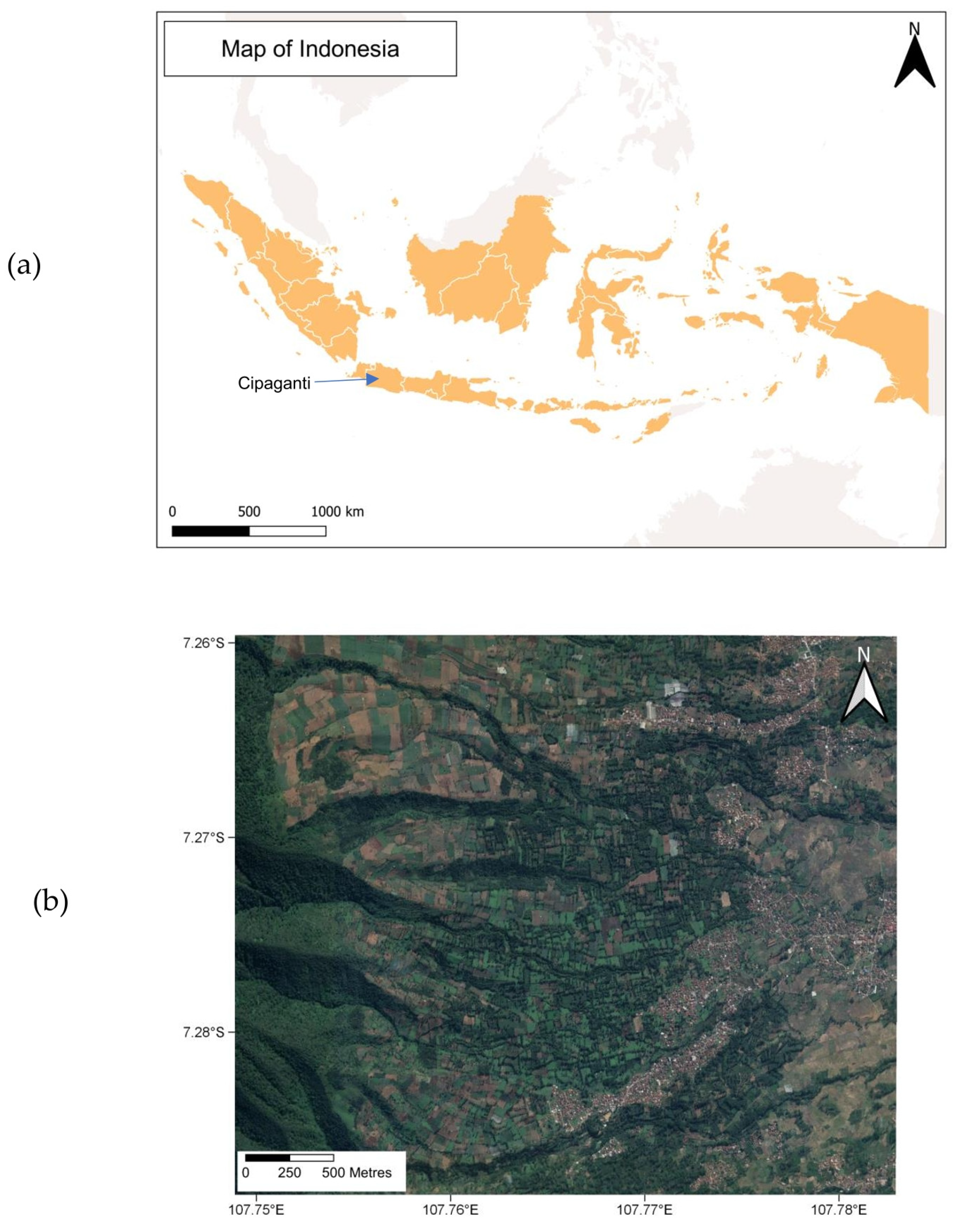
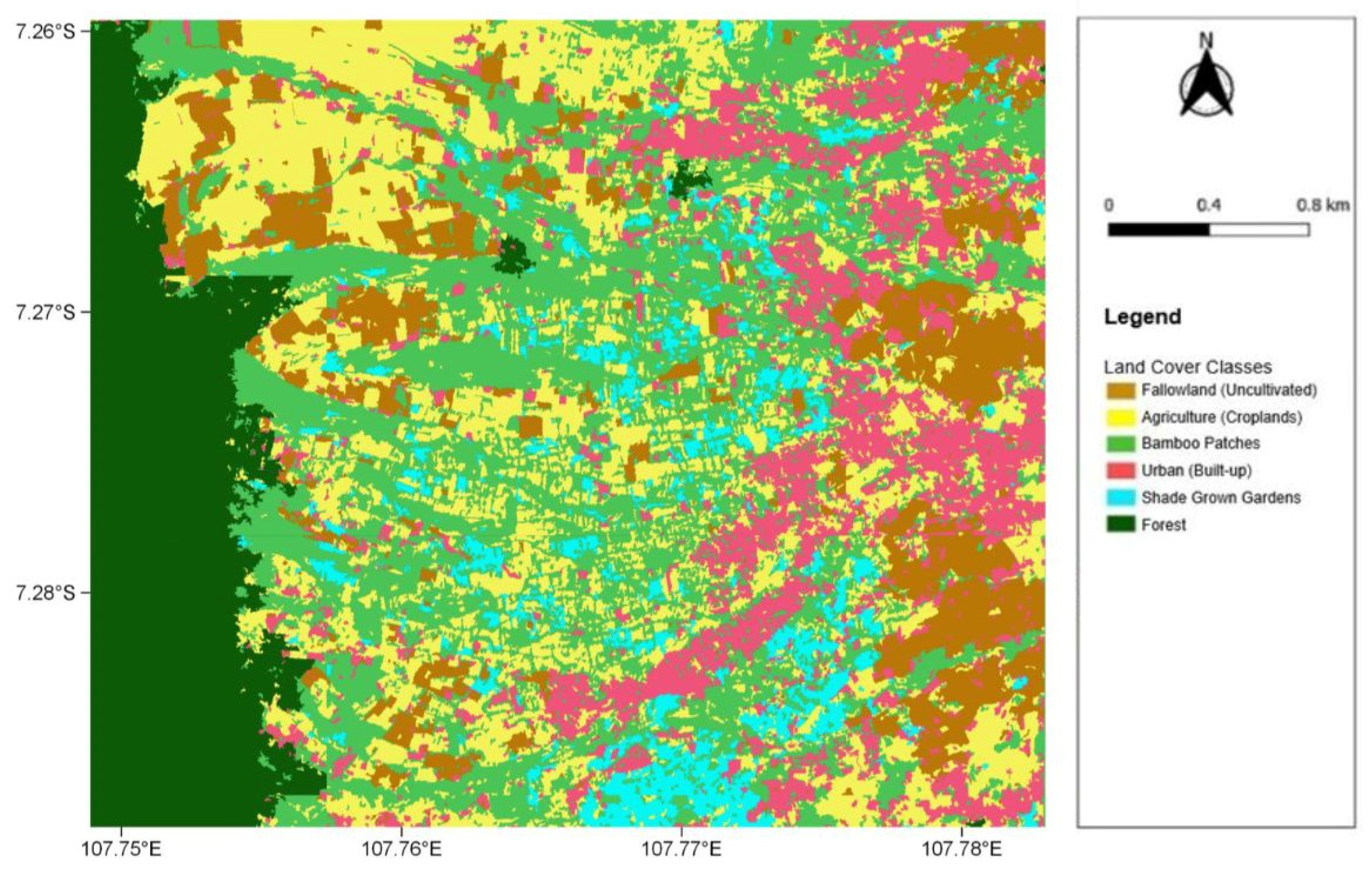
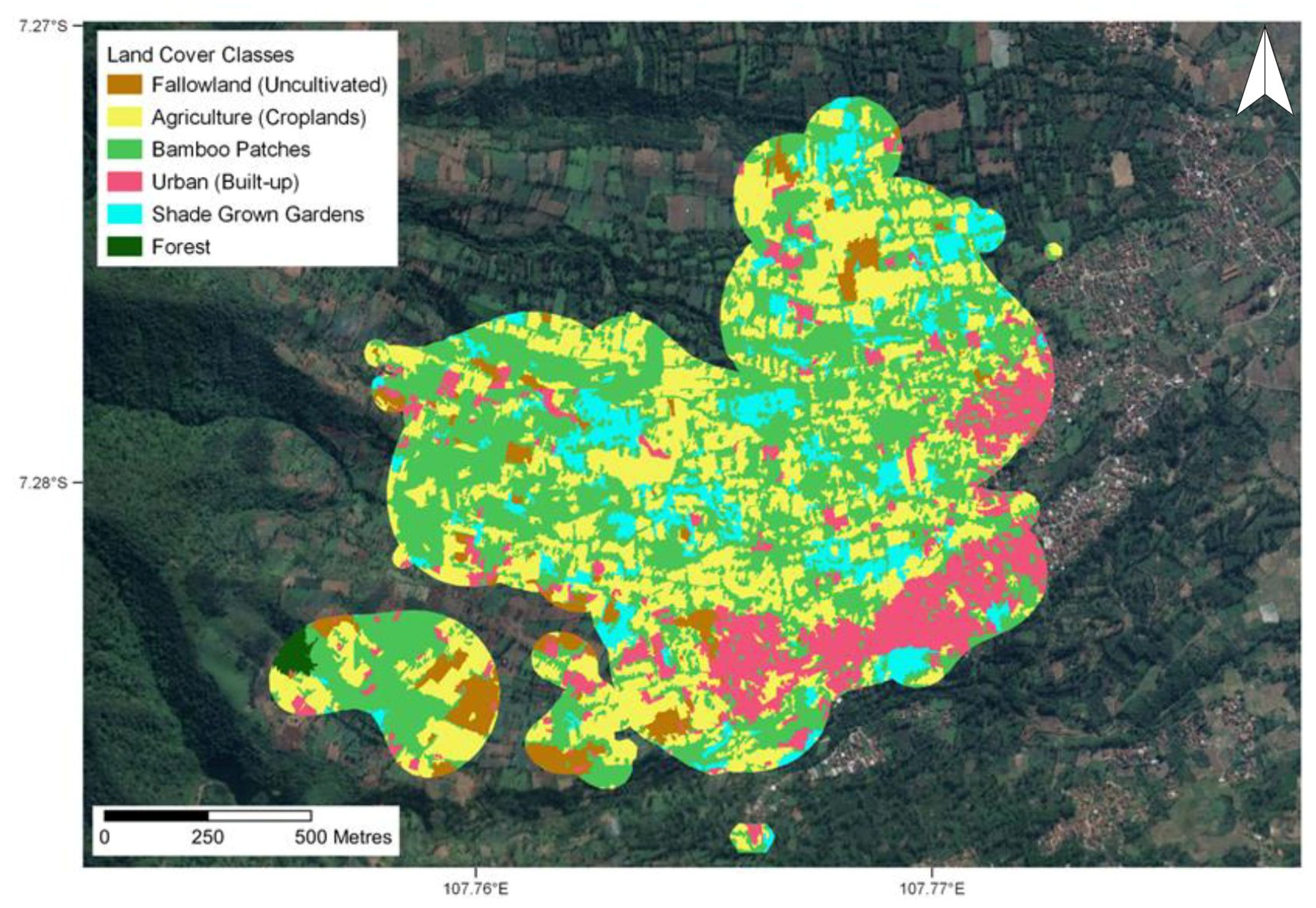
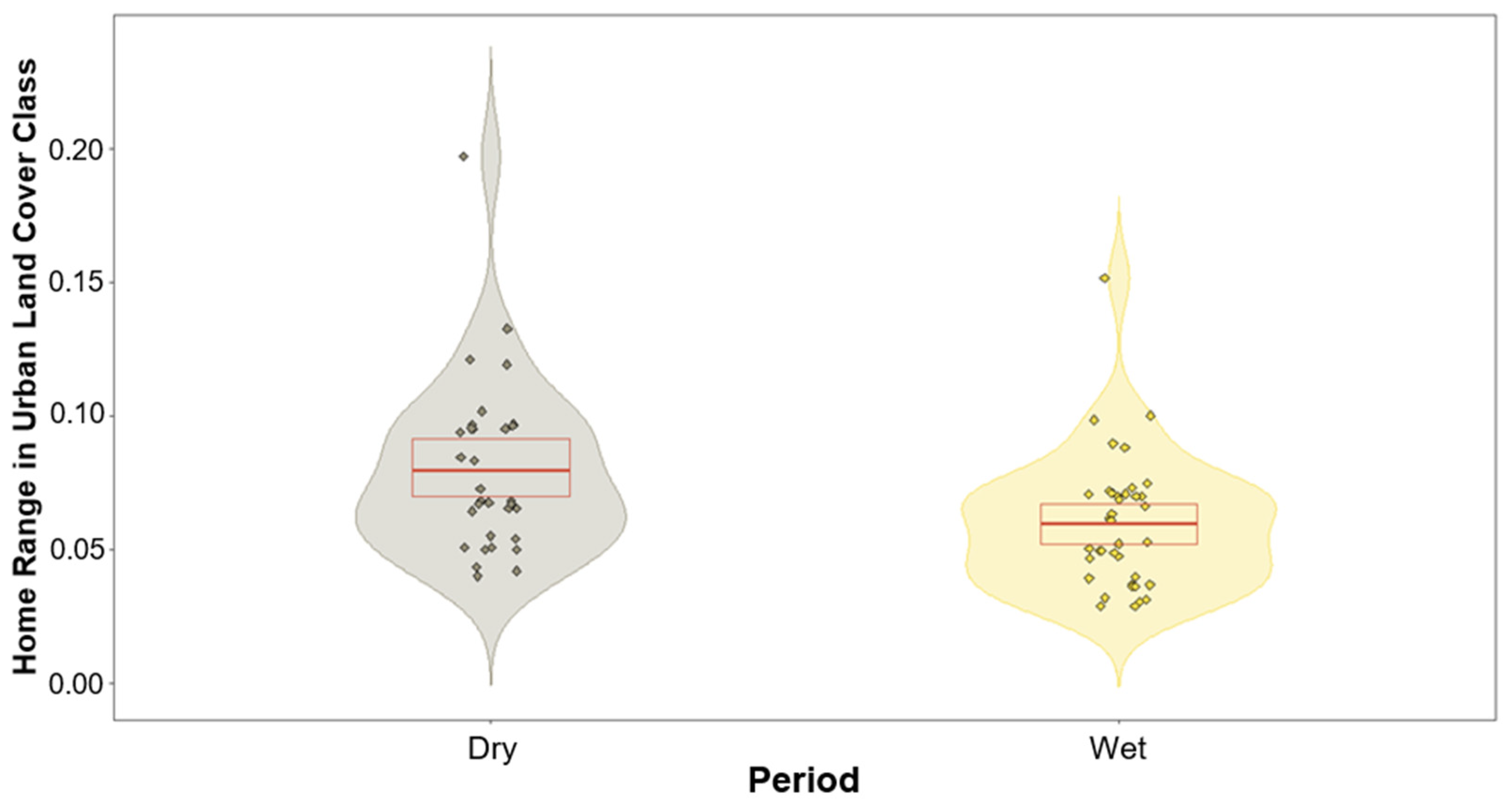
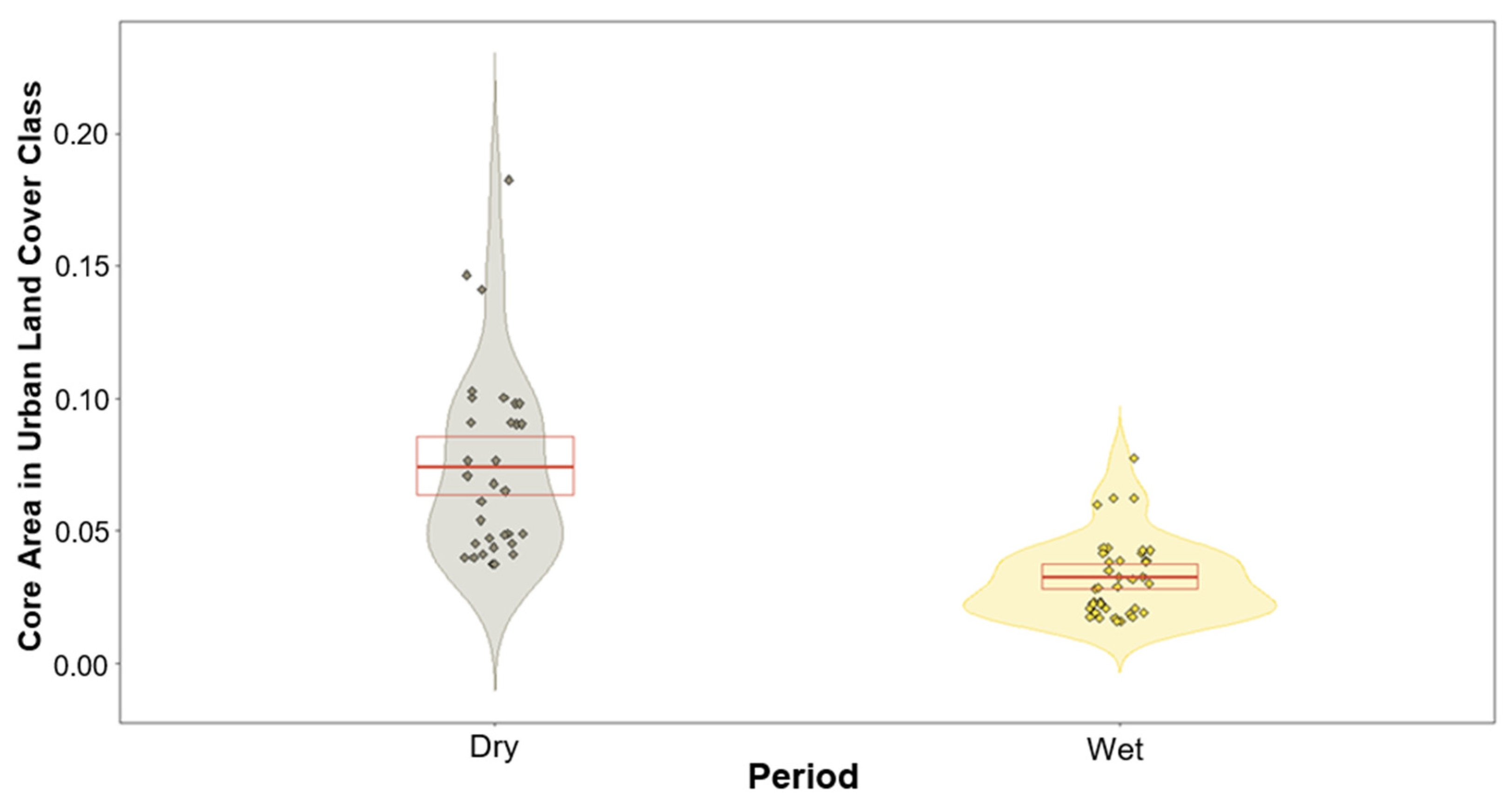

| Estimate | Standard Error | z-Score | p-Value | ||
|---|---|---|---|---|---|
| Home Range | Fallow Land (Uncultivated) | 0.2697 | 0.2161 | 1.248 | 0.212 |
| Agriculture (Cropland) | 0.007144 | 0.077988 | 0.092 | 0.927 | |
| Bamboo Patches | 0.08459 | 0.08753 | 0.967 | 0.334 | |
| Urban (Built-up) | −0.3392 | 0.1831 | −1.852 | 0.064 | |
| Shade Grown Gardens | −0.08578 | 0.15974 | −0.537 | 0.591 | |
| Core Area | Fallow Land (Uncultivated) | −0.1265 | 0.2722 | −0.464 | 0.642 |
| Agriculture (Cropland) | −0.02767 | 0.13376 | −0.207 | 0.836 | |
| Bamboo Patches | 0.1736 | 0.1359 | 1.278 | 0.201 | |
| Urban (Built-up) | −0.8573 | 0.2773 | −3.092 | 0.00199 | |
| Shade Grown Gardens | 0.1876 | 0.1913 | 0.981 | 0.327 |
Disclaimer/Publisher’s Note: The statements, opinions and data contained in all publications are solely those of the individual author(s) and contributor(s) and not of MDPI and/or the editor(s). MDPI and/or the editor(s) disclaim responsibility for any injury to people or property resulting from any ideas, methods, instructions or products referred to in the content. |
© 2023 by the authors. Licensee MDPI, Basel, Switzerland. This article is an open access article distributed under the terms and conditions of the Creative Commons Attribution (CC BY) license (https://creativecommons.org/licenses/by/4.0/).
Share and Cite
Karimloo, L.; Campera, M.; Imron, M.A.; Rakholia, S.; Mehta, A.; Hedger, K.; Nekaris, K.A.I. Habitat Use, Terrestriality and Feeding Behaviour of Javan Slow Lorises in Urban Areas of a Multi-Use Landscape in Indonesia. Land 2023, 12, 1349. https://doi.org/10.3390/land12071349
Karimloo L, Campera M, Imron MA, Rakholia S, Mehta A, Hedger K, Nekaris KAI. Habitat Use, Terrestriality and Feeding Behaviour of Javan Slow Lorises in Urban Areas of a Multi-Use Landscape in Indonesia. Land. 2023; 12(7):1349. https://doi.org/10.3390/land12071349
Chicago/Turabian StyleKarimloo, Laura, Marco Campera, Muhammad Ali Imron, Shrey Rakholia, Abhinav Mehta, Katherine Hedger, and K.A.I. Nekaris. 2023. "Habitat Use, Terrestriality and Feeding Behaviour of Javan Slow Lorises in Urban Areas of a Multi-Use Landscape in Indonesia" Land 12, no. 7: 1349. https://doi.org/10.3390/land12071349
APA StyleKarimloo, L., Campera, M., Imron, M. A., Rakholia, S., Mehta, A., Hedger, K., & Nekaris, K. A. I. (2023). Habitat Use, Terrestriality and Feeding Behaviour of Javan Slow Lorises in Urban Areas of a Multi-Use Landscape in Indonesia. Land, 12(7), 1349. https://doi.org/10.3390/land12071349








